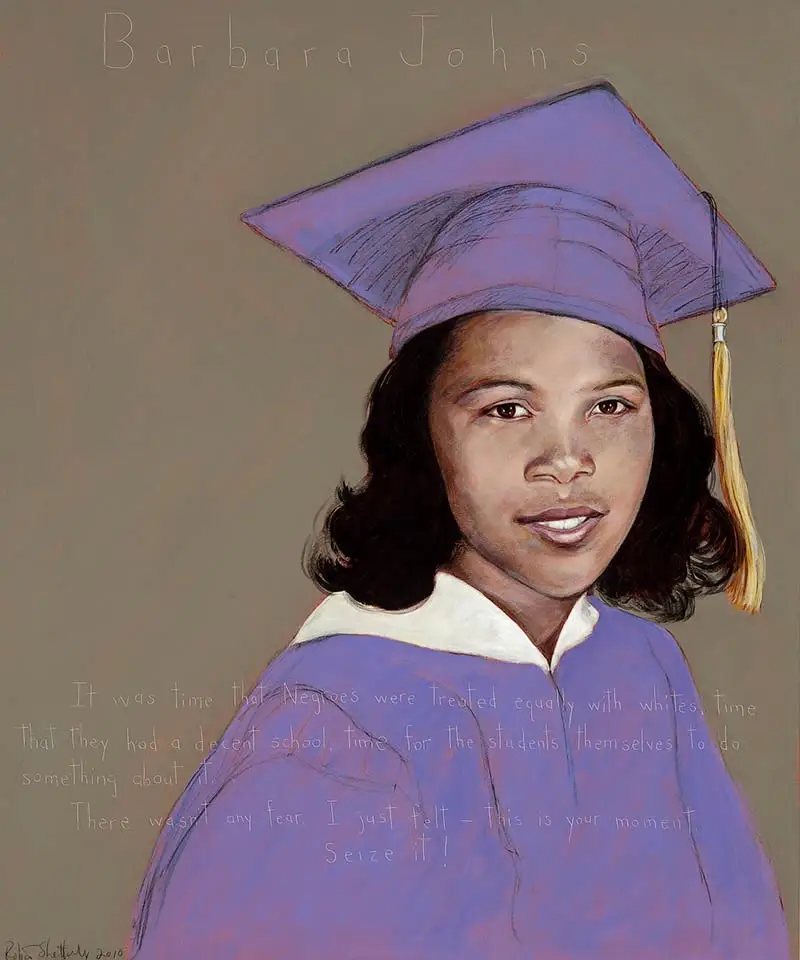
Barbara Johns
Barbara Johns
Civil Rights Activist : 1935 - 1991
“It was time that Negroes were treated equally with whites, time that they had a decent school, time for the students themselves to do something about it. … There wasn’t any fear. I just thought – this is your moment. Seize it!”
Why I painted Barbara Johns
AWTT artist Robert Shetterly explains how Barbara Johns' actions as a high school student led to school desegregation.
Biography
Barbara Rose Johns was born in New York City in 1935 to Violet and Robert Johns. During World War II, she moved to Farmville in Prince Edward County, Virginia, to live on a farm with her maternal grandmother, Mary Croner. She spent most of her youth living and working on her grandmother’s farm, then later her father’s farm.
After years of frustration with the segregated Prince Edward County schools – which she described in a memoir as having poor facilities, shabby equipment, and no science laboratories or gymnasium – Barbara voiced her complaints to a teacher, who responded by asking her to “do something about it.” Barbara describes feeling as though her teacher’s comments were dismissive, and as a result she was somewhat discouraged. However, after months of contemplation and imagination she began to formulate a plan.
As Barbara described it, “The plan I felt was divinely inspired because I hadn’t been able to think of anything until then. The plan was to assemble together the student council members. … From this, we would formulate plans to go on strike. We would make signs and I would give a speech stating our dissatisfaction and we would march out [of] the school and people would hear us and see us and understand our difficulty and would sympathize with our plight and would grant us our new school building and our teachers would be proud and the students would learn more and it would be grand.”
Seizing the moment, on April 23, 1951, Barbara Johns – by then a sixteen-year-old high school student – led her classmates to strike in protest of the substandard conditions at Robert Russa Moton High School. Her idealism, planning, and persistence ultimately garnered the support of NAACP lawyers Spotswood Robinson and Oliver Hill, who took up her cause and the cause of creating more equitable conditions for Moton High School.
After meeting with the students and the community, lawyers Robinson and Hill filed their case, Davis v. Prince Edward, at the federal courthouse in Richmond, Virginia. In 1954, the Farmville case became one of five cases that the U.S. Supreme Court reviewed in Brown v Board of Education of Topeka, the landmark ruling that school segregation was unconstitutional.
Sometimes a courageous act by one person can set in motion a series of events that bring justice to an entire nation.
After the strike, followed by reactionary threats from local racist groups, Barbara’s family became concerend for her safety. They sent Barbara to Montgomery, Alabama, to finish her schooling. After graduating from high school, she attended Spelman College in Atlanta, Georgia, and ultimately graduated from Drexel University in Philadelphia, Pennsylvania. Barbara Johns went on to lead a quiet life; she married the Reverend William Powell, raised five children, and was a librarian in the Philadelphia Public Schools. Barbara Johns Powell died in 1991.
Note: Thanks to the Moton Museum for contributing the original version of this biographical summary.
Programs
Americans Who Tell the Truth (AWTT) offers a variety of ways to engage with its portraits and portrait subjects. Host an exhibit, use our free lesson plans and educational programs, or engage with a member of the AWTT team or portrait subjects.

Education
AWTT has educational materials and lesson plans that ask students to grapple with truth, justice, and freedom.

Exhibits & Community Engagement
AWTT encourages community engagement programs and exhibits accompanied by public events that stimulate dialogue around citizenship, education, and activism.